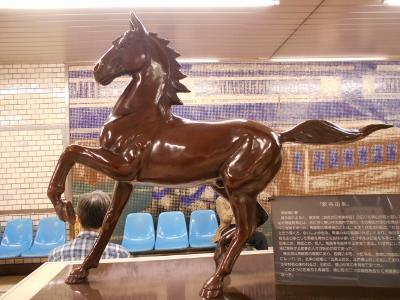I got off at Bakuro-Yokoyama Station on the Toei Shinjuku Line. The station is decorated with a dynamic horse bronze statue.
Next to it, "Derived from the station name" is posted. According to the report, Bakuro-Yokoyama Station
`` According to the Kanei era figure, the north and south of Bakurocho, where the area around Hashimoto-cho (currently Nihonbashi Honmachi) is described as Yokoyama Katamachi, are both old in the area of Yokoyama Katamachi, and the north side of Yokoyama Katamachi is a temple. Was. Hakuroshi of Bakurocho said in a diary of 1590, "I would like a horse chestnut called Takagi, a yuisho proposal, a picture of the land of Baba." I wrote it at that time, but originally Hakuraku was the main character.
Hakuraku is a word that refers to horse doctors, pastors, horse merchants, etc. In any case, it was a town that was started by horse-related family businessmen.
Yokoyamacho was located on the south side of Bakurocho, Honmachi and Otemmacho on the west side, and Ryogoku Hirokoji on the east side. It is written in Hojo's role book, "Sanuki 300 sentences, Edo Yokoyama", which is thought to be a small village name, but at first it was a certain property of Yokoyama.
In this way, the two historical places of Bakurocho and Yokoyamacho merged to form Bakuro-Yokoyama Station. ]
In this area, Ieyasu Tokugawa gathered war horses for the battle of Sekigahara, and a mansion of the Kanto Army was established on the north side of Bakurocho, and Otemmacho developed on the west side. It can be seen that it was a necessary land for horses.


